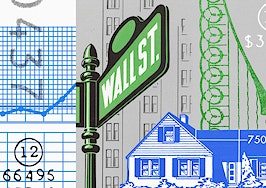This report is available exclusively to subscribers of Inman Intel, a data and research arm of Inman offering deep insights and market intelligence on the business of residential real estate and proptech. Subscribe today.
Why real estate is so popular with venture capitalists is one question Inman sought to answer when we spoke with Brendan Wallace, co-founder and managing partner of Fifth Wall, the New York City-based B Corp with an environmental bent and a penchant for proptech.
Venture capital firm Fifth Wall closed an $866 million proptech fund in December, a few months after announcing a $500 million climate fund — “the largest private fund formed to de-carbonize the real estate industry,” as they put it.
In an interview with Intel, co-founder Brendan Wallace was able to concisely explain why proptech is so worthy of its venture capital relationships, how mortgage process friction makes money for lenders and that in order to reduce real estate’s carbon footprint, it helps to understand physics.
This interview has been edited for length and clarity.
Inman: What is the most prominent challenge for the real estate industry at the moment?
Wallace: There has been a pretty dramatic slowdown in home purchasing, and I’m sure you know there are a lot of businesses, tech and otherwise, that are highly levered to people buying homes. In turn, when they buy those homes, there’s a constellation of financial products, ancillary financial instruments that you need to buy a home. From home insurance to title insurance to home warranties to mortgages, all of the downstream industries have been adversely affected by the rate hikes.
I think residential is particularly challenging because it’s an industry that depends on a high-velocity capital market, at least historically, and we’ve seen the most sudden, most dramatic and most abrupt change to cost of capital in that capital market that we’ve ever seen. That’s a real challenge.
The industry and technology and fintech business will be metabolizing the downstream consequences of seven percent interest rates for quite some time.
Let’s talk about one of those ancillary business lines. What needs to be changed to fix the broken consumer experience in lending?
It is still a very archaic industry, and we tend to creep up on this question by virtue of talking about the other parts of buying a home that have been rendered more efficient by technology and how mortgages have been left behind.
The way you discover a home today is fundamentally different than how you discovered a home pre-dawn of the Internet. We have Zillow, which allows us to instantly and seamlessly discover a home, comps for that home, pictures, price history and leverage information technology to make a more informed decision on the home we ultimately want. What’s interesting is that once we go to capitalize the purchase of that home, it seems like we regress to the anachronistic process of underwriting a mortgage, where you’re pretty much dealing exclusively with offline, analog processes.
To be clear, there are some great solutions out there, like Blend (a Fifth Wall-backed company) that have digitized elements of the underwriting process, but by and large, the process is pen and paper, increasingly digital, but overwhelmingly offline. It’s still rife with friction, and it’s kind of an opaque process to the consumer too.
The reasons for that are manyfold, and I don’t have a great explanation for why mortgage is the laggard in digitization, but I think there’s a lot of vested interest in, around the mortgage industry. It has allowed to persist as an inefficient industry, because people aren’t making that many home purchases in their lives, it’s not something you’re doing multiple times a year, so you forget the pain of the experience.

Brendan Wallace| photo by Lev Gorn, Fifth Wall
I can securely send someone $1,000 on Venmo in seconds. Why aren’t lending industry leaders embracing that kind of concept?
A part of it is the agents today, on the buy and sell side and on the mortgage side, in some ways, they function on and are able to generate fees by in some ways acting like a small-scale investment bank. In the process of all those phone calls and voicemails and follow-up emails, [through] the frenetic activity that’s required to get a mortgage closed, they’re able to justify fees. Everyone has an interest in making it a more frictionless process, but because so many people are able to generate fees by that friction existing, there’s resistance to change.
The financial markets we find ourselves in today are less impacted by housing than the global financial crisis 12 years ago, but at the same time the housing capital markets are the largest on earth, depending on how you look at them, they’re larger than the U.S. equity and debt market. So, they’re the most consequential markets that operate in the least efficient way. Think about how seamless it is to buy and sell a stock, yet the largest capital market, in which the majority of Americans have their wealth tied up, is just rife with inefficiency and friction.
Fifth Wall is centered on making real estate more sustainable, as an aside, why hasn’t America embraced smaller, more efficient homes? Do you have any research on that topic?
To be clear, we are optimistic about companies like Veev, and we invested in another company called Assembly, which is trying to reduce the time and cost and friction of building. The reason it’s been a very challenging space, well, some people draw the analogy to the fact that there are so many products that we consume today that we can manufacture with speed and efficiency, but buildings and homes have been left behind.
Well, there are a lot more materials in buildings and homes. The real estate industry consumes 40 percent of the world’s raw materials, and the heterogeneity of those materials inside a home is vast, more than what you’ll find in a car or mobile phone, so the challenge of building a modularized home or multifamily housing or industrial construction solution is so daunting.
The solutions we’re more optimistic about, like Veev and Assembly, have a particular form factor that they are focused on, and in so doing, can be very specific about the type of product they’re delivering. It can be repeatable, and they can miniaturize the fabrication facilities that are required. Shipping a truss, you know, from China to build a home in Kansas isn’t like shipping an iPhone.
There are certain discontinuities with the rest of how we’ve industrialized the economy that break down around real estate, but I think we’re seeing the first generation of companies that can overcome that.
Why is proptech growing so quickly?
We’re seeing a real maturity in the proptech ecosystem, maturity in the sense that there’s a lot of capital flowing in the space and companies that have been around for quite some time. Those more mature businesses can become consolidators, companies that can drive M&A in the space, and the landscape has become more broad and sophisticated and nuanced. It wasn’t like that when we started, the footprint is more complex and mature.
The second thing is institutional investors, large allocators of capital they have seen. If you look at the growth of proptech, it actually exceeds the growth of fintech which has been an enormous moneymaker to venture capital. The reasons for that are obvious. Real estate is a larger percentage of U.S. GDP than financial services, and it’s by far a less technologized sector. So when you gave 13 percent of U.S. GDP, which is real estate industry, adopting technology voraciously as it has been, a lot of value has been created and venture capital sees that.
The third driver is strategic investors, both U.S. and international, so the largest owners, operators and developers of real estate in the U.S. and globally are recognizing that investing in proptech isn’t a nice-to-have; it’s arguably existential to their business. Real estate had been historically this industry in which, if you were owner or operator or developer, you didn’t need a well-informed point of view on how technology is changing your industry. But I’d argue that in the last five years that assumption has been shattered.
And absolutely, every CEO in the real estate industry knows they need a lens, a perspective on and access to technology.
What does Fifth Wall like to see in a proptech pitch? What are you looking for?
What we really like to see are businesses where we have an edge in accelerating them. Fifth Wall model is that we have all these strategic LPs (limited partners, i.e. investors), 110 from 16 different countries, and vis-a-vis those relationships, we can open these distribution lanes to support our portfolio companies.
And so, what we love to see is an instance where there’s a technology that has some product market fit, it has some reference customers, it’s working, it’s solving a pain point but hasn’t quite scaled. We want to open our aperture, those distribution lanes and then rapidly accelerate that growth, and do so not just in the U.S., but increasingly we have international LPs, we can help a technology company expand into Western Europe, the U.K. and Spain and France, into Japan and China and Singapore. That’s what we really like doing, that’s the real center of the bull’s eye.
What does Fifth Wall do for a company beyond the financial?
I’d say that Fifth Wall is probably the most sought-after proptech investor because what we can do that’s unique is grow their revenue vis-a-vis our strategic LPs. Fifth Wall’s specificity is that we can say we’re here to help grow your business by virtue of our strategic relationships.
How did Fifth Wall’s stance on the environmental impact of real estate happen? Was it there from the outset or did it evolve?
It was an evolution. It grew out of these relationships with our strategic investors. The way I think about it is, if you think about proptech at the most essential level, what proptech means … there’s this famous Mark Andreessen quote, ‘Software is eating the world.’ And the way I think about proptech at the most simplistic level is that software is eating the real estate industry, or at the very least, it’s colliding with it.
When you have 13 percent of the economy that’s never adopted tech start to adopt tech, a lot of value gets created. But what that software does is renders efficiency on anything and everything the real estate industry represents.
To be clear, the products themselves are software, they’re lines of code. That’s what proptech is. But, in reference to what we talked about earlier, 40 percent of the raw materials in the world go into real estate. So this is as much a raw material industry as it is a software industry, and we had major real estate owners coming to us and saying, ‘hey, we need Fifth Wall’s help in evaluating this carbon-sequestering concrete or this smart glass company or this stationary battery or micro-grid business.’
When you look at those companies, you’re no longer looking at lines of code, you’re looking at atoms, physical stuff, manipulating the physical world. So we saw this opportunity to ask: Can we take the same model that we pioneered around software and start focusing it on anything and everything to decarbonize the real estate industry? To do that, we need to invest in physical stuff as well as software.
Thanks for your time Brendan, any parting thoughts?
I think there’s an enormous opportunity for innovation in residential real estate, and I believe that a lot of that innovation can truly come from the people who are on the ground, who have domain expertise and know the space. And while I expect that we may enter a more challenging capital market with respect to housing in the U.S., I think this is an amazing time to build new companies that solve pain points. I’m always optimistic about challenging times creating opportunities for innovation.
And I’m really excited about what the next five years may represent and the companies your readers may build.
New markets require new approaches and tactics. Experts and industry leaders take the stage at Inman Connect New York in January to help navigate the market shift — and prepare for the next one. Meet the moment and join us. Register here













